Yowie Representations
Posted by: Loren Coleman on June 2nd, 2009
Newspapers around the world generally don’t run a story of a hairy hominoid without trying their hand at illustrating it with a drawing of the beast. How has the Yowie fared in the realm of representative art?
For most Americans, the image of what a Bigfoot looks like is rather standardized. Is the same true of the Australian Yowie?
Here are some examples of the Yowie imagined or represented.

This little drawing is of the Yowie called “The Bombala Anthropoid – a specimen of the tribe, drawn by Will Diamond from a description given by Mr. Charles Harper” as shown in The Sydney Sun of November 10, 1912.
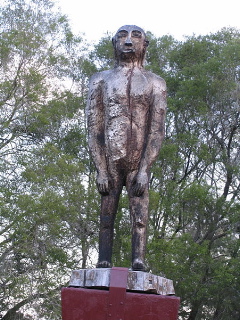
A wooden Yowie statue found in Kilcoy, Queensland, Australia.
Is there something strangely human about that wooden Yowie head?
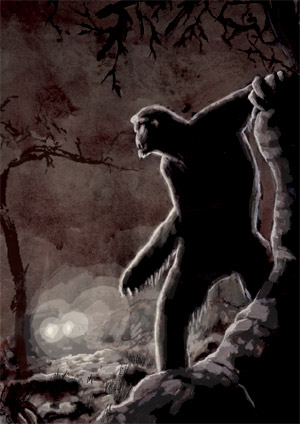
Yowie illustration (above) by Xavier Lemmens for Fortean Times.
Are the Yowies relatives of the Aborigines, misidentified and said to be covered with hair?
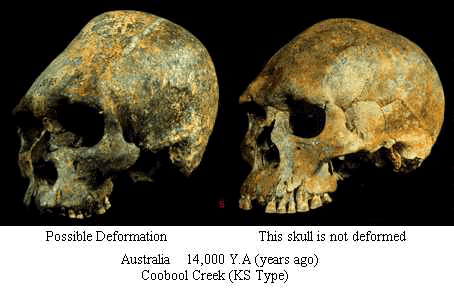
Perhaps Yowies are merely evolved Kow Swamp hominids (the skulls of the Kow Swamp/Coobool population being shown above)?
Or are Yowies completely unlike Bigfoot, indeed, a different species?
Are Yowie more closely related to Yeti? Or to Asia’s Malaysian unknown hairy primates?
To orangutans? To Orang Pendek?
Or even have links to African unknown hominoids?
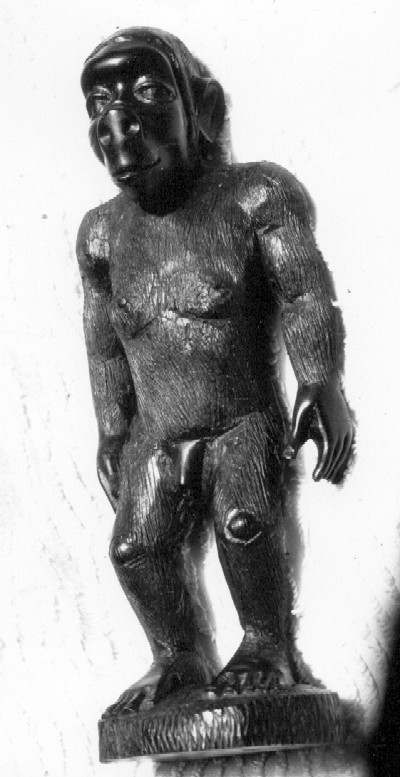
Is there a link to this wooden representation of a Proto-Pygmy, the Agogwe from Africa.
Or do Yowies look like unknown hominoids from elsewhere?
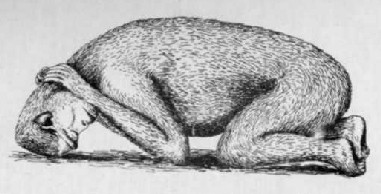
This is the sleeping position of an Almas seen in the Gobi Desert, Mongolia.
Are Yowie more hominid than pongid?
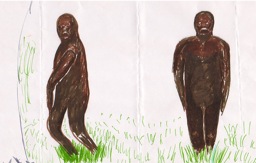
This is a recent eyewitness drawing of a Yowie from Australia.

Please take a closer look at the Agogwe, the Almas, the wooden Kilcoy Yowie, and the above illustrated Yowie. They all appear to have calluses on their knees, which have been explained by the Russian researchers as a result of the above shown sleeping position, demonstrated for the Almas.
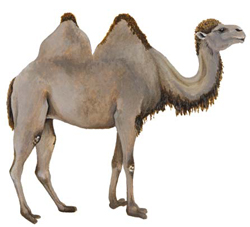
These heavily callused knees are sometimes referred to as “camel knees,” because of their obvious likeness to the knees of camels. The hardening of the skin of the knees in camels is due to the evolutionary fact that the camel’s knees (as shown in the Bactrian above) were adapted for bending down on the sands of its native Gobi desert, to rest and sleep.

This drawing of a Yowie was created by Michael Skelton and his daughter after an alleged encounter near Victoria, Australia, in 2006.
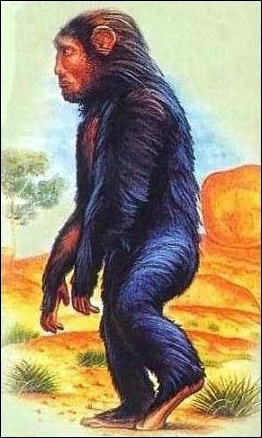
This is another artist’s impression of the Yowie.
Click on the image above to make the Yowie larger, as seen here on the cover of The Yowie: In Search of Australia’s Bigfoot.
What kind of hominoid is the Yowie?
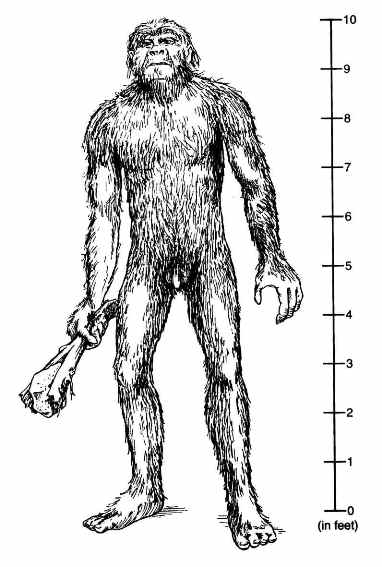
The creature above is a variety of the Yowie seen with a club, as viewed in Harry Trumbore’s drawing from The Field Guide to Bigfoot and Other Mystery Primates, 2006.
Is the Yowie something other than the classic Bigfoot?
About Loren Coleman
Loren Coleman is one of the world’s leading cryptozoologists, some say “the” leading living cryptozoologist. Certainly, he is acknowledged as the current living American researcher and writer who has most popularized cryptozoology in the late 20th and early 21st centuries.
Starting his fieldwork and investigations in 1960, after traveling and trekking extensively in pursuit of cryptozoological mysteries, Coleman began writing to share his experiences in 1969. An honorary member of Ivan T. Sanderson’s Society for the Investigation of the Unexplained in the 1970s, Coleman has been bestowed with similar honorary memberships of the North Idaho College Cryptozoology Club in 1983, and in subsequent years, that of the British Columbia Scientific Cryptozoology Club, CryptoSafari International, and other international organizations. He was also a Life Member and Benefactor of the International Society of Cryptozoology (now-defunct).
Loren Coleman’s daily blog, as a member of the Cryptomundo Team, served as an ongoing avenue of communication for the ever-growing body of cryptozoo news from 2005 through 2013. He returned as an infrequent contributor beginning Halloween week of 2015.
Coleman is the founder in 2003, and current director of the International Cryptozoology Museum in Portland, Maine.

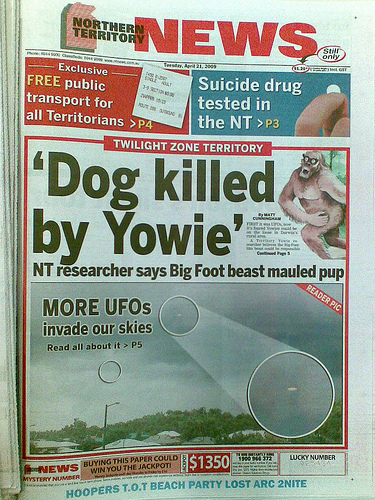
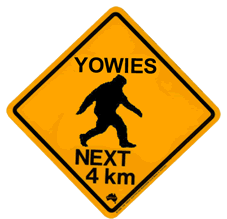
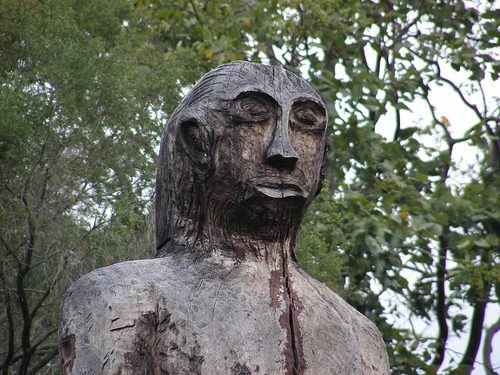
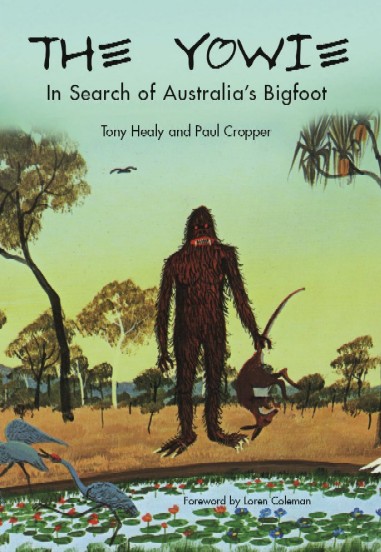









I’m not a fan of the Yowie saga, though fully supportive of Bigfoot, the Almas, etc. If there’s a shred of reality in the Yowie then I can’t see how it can be pongoid. There’s not been a landbridge between Indonesia and Australia capable of supporting movement of the species since before the first primates appeard (going by known fossil primate evidence). Other landbridge from memory was Antartica many multi millions of years before.
Which would, I should think, mean that if it exists it’d have to have rudimentary sea-faring ability to get here. Which would suggest a species of Homo. We know Australian Aboriginals are fully modern humans, the mungo skeletons appearing to be somewhat earlier than current inhabitants, but none the less “modern” of possibly archaic modern (debated), so the next contender would have to be Erectus. But we have zero fossil evidence for this. Admittedly Australia has a disaterous record of fossil preservation due to the climate.
Let’s not forget that the “origin” of the Aboriginal people themselves is kinda a mystery. Also don’t forget that we have heard stories of “unknown” (apparently only to us) species traveled around the pacific with the Polynesians (of course I’m referring to the “little people” in the legends of the south pacific islands). We also know that the ancestors of the Aboriginal people inhabited many other islands, so we really don’t know their place of true origin. The ancestors who first traveled to Australia might have brought it. Thought…Has anybody asked the Aborigines about the Yowies? We know that most Native Americans saw Sasquatch as human, calling them cannibals. Some saw Sasquatch as a go between to the spiritual world. Then again thinking of the story about how the Kangaroos got their name the Aborigines may not have them in their language. I would think more hominoid. Not saying totally human or missing tribe thing, but smart enough to avoid most people all this time. Then again it might be way smarter than us and has technology that allows it to “disappear”…
Crazy thought here, could the Yowie be a marsupial? Maybe gone through some similar or convergent evolution as the sasquatch? I know the thought is far fetched, but sometimes my brain is pretty out there, haha.
Averagefoot: I violently disagree with you.
I mean, on the “crazy” part. The “far fetched” part. The “out there” part.
In a “science” which someday should really get there, if there’s one “out of the box” idea I have heard that ISN’T crazy, or maybe I should rephrase that to “is testable,” it’s that the Yowie may be a marsupial. That’s a proposition that can be tested, unlike, say, “the sasquatch is a supernatural being.”
I even think I might have propounded that idea here once some time back.
One might think that encounter reports should have picked up on this sooner or later. Then again. Seeing a marsupial without young in its pouch, one wouldn’t know it was one. You’d have to have sighting records of such a thing, if not photos and a body. Now, I’m not aware of any. But with cryptids, absence of evidence is not etc.
As has been pointed out here, it’s a pretty farfetched idea that there’s a native ape in Oz in the first place. A marsupial, from what we know, actually makes MORE sense. Remember, the only native placentals in Australasia are bats. And even they came there from somewhere else – and they had the means. (A not-so-aside here: the Yowie seems to me to have some not-so-primate features, too.)
I haven’t read anything that would even lead me to believe that the Yowie has the cranial capacity of the apes. That, if I am wrong, is simply ignorance of the evidence. And of course there is no reason why the Yowie could not be the product of a parallel evolutionary track in which – as with primates – eyes hands feet and brain worked together over millennia to make each other stronger.
We have too many blinkers that keep us from considering possibilities in crypto. That’s why people go off on these it-can-disappear-orb-and-shapeshift tangents: the blinkers. One of the worst of those blinkers: thinking something is impossible because no one has confirmed it yet.
The sasquatch is a very, very plausible animal. So is the yeti. And too many people – unfortunately including too many proponents – don’t understand this, and make stuff up.
If they are plausible…well, so is a marsupial ape. Says here.
I should add an excerpt from Mungo Man on Wikipedia.
—————————————
The study (of “Mungo Man,” Oz’s oldest known modern-human remains) has been controversial because it presents a challenge to the “Recent Out of Africa” theory of human evolution, which holds that all humans are entirely descended from common ancestors who originated in Africa within the last 200,000 years. The study authors proposed that their results support the multiregional hypothesis, which holds that traits of modern humans evolved in several places around the world, and that gene flow created the genetic uniformity seen today, not a recent migration of a single population from Africa.
—————————————
Not sure what geology says about the possibility that primate evolution in general might have occurred in the same or a similar way. And I know the fossil record of Oz is silent on this. But the fossil record is also always incomplete. I think that the story of how the Aborigines made it to Oz may have chapters in it that we can’t imagine with what we “know” now. And the story of primate evolution might, as well.
Or the Yowie came to Oz in someone’s boat. OK there, I guess.
The more I read about similarities between the yowie and the sasquatch the more uncomfortable I feel about the reality of the yowie.
Although of course the eyewitness reports go back a long way for both.
Has anyone considered the possibility that a southern population of gigantopithecines moved south to colonize Oz, while a northern population moved to colonize North America? Because if that can be ruled out, I’m running out of ideas. Unless there is a lot about primate evolution that the fossil record isn’t telling us.